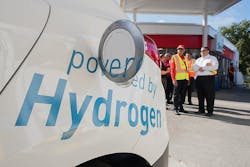Southern California Gas utility proposing Angeles Link to connect Hydrogen infrastructure into LA Basin
The push for so-called green hydrogen faces many financial and logistical hurdles, but momentum is building from its many well-invested supporters.
A big push was announced late last week, as utility giant Southern California Gas Co. detailed plans for what it called the nation’s largest green hydrogen infrastructure system to bring carbon-free H2 into the Los Angeles region. Hydrogen itself does not burn a carbon atom, but to be truly green it must be produced from electrolysis (separating the H2 from water) powered by carbon-free energy resources such as wind, solar or nuclear.
The Angeles Link would move green hydrogen at volumes equivalent to 25 percent of SoCalGas’ current natural gas delivery amounts. The utility says that infrastructure would displace up to 3 million gallons of diesel fuel per day by replacing those heavy-duty trucks with hydrogen fuel-cell trucks.
The supply chain, if fully realized, also would provide zero-carbon or carbon-neutral fuel to convert up to four natural gas-fired power plants to green hydrogen, according to the release.
"The challenges we face on climate require solutions of scale and urgency," said Scott Drury, chief executive officer of SoCalGas. "The Angeles Link is designed to meet those challenges head-on. Today in Southern California we're announcing plans for one of the world's largest clean energy infrastructure systems, to help tackle emissions for which there are no easy answers. Those emissions – from power plants, industry, and heavy-duty trucks - very much 'count' and must be significantly reduced to reach our and the State's climate goals."
The Angeles Link would tie in together with numerous parallel green H2 projects. The Los Angeles Department of Water and Power already is a planned off-taker for a massive Intermountain Power Plant project in Utah.
In addition, the LADWP and SoCalGas are working with non-profit HyDeal Los Angeles, Mitsubishi Power and others to scale up hydrogen production so that costs can drop to about $1.50 per kilogram produced in the LA Basin by 2030.
Related stories
Siemens Gamesa produces Green Hydrogen at Denmark site
Teams working on H2 storage idea for Clemson University campus
See EnergyTech's full coverage of Hydrogen's Future in the C&I Energy Transition
Subscribe to our free, tri-weekly Email Newsletter for more stories like these
Seven years ago, SoCalGas launched a power to gas hydrogen demonstration project. The SoCalGas H2 Hydrogen Home Microgrid demonstration is testing movement of H2 through existing natural gas infrastructure.
"We are encouraged that SoCalGas is embarking on a major project that will help make green hydrogen a reality here in Los Angeles," said Marty Adams, Chief Engineer and General Manager of Los Angeles Department of Water and Power (LADWP). "Developing a source of safe, affordable green hydrogen is key to achieving our clean energy future by 2035, while ensuring the reliability we all need and depend on. Projects like the proposed Angeles Link are an important step forward."
Some skeptics, while acknowledging the carbon-free potential of hydrogen in the fuel mix, point to potential costs of additional hundreds of billions of dollars, likely trillions to make it happen at scale. Hydrogen is a different, much lighter form of gas presenting challenges in storage, distribution and combustion, as well as production since it is not found in concentration but must be created from electrolysis or steam reforming of methane.
-- -- --
(Rod Walton, senior editor for EnergyTech, is a 14-year veteran of covering the energy industry both as a newspaper and trade journalist. He can reached at [email protected]).
About the Author
Rod Walton, EnergyTech Managing Editor
Managing Editor
For EnergyTech editorial inquiries, please contact Managing Editor Rod Walton at [email protected].
Rod Walton has spent 17 years covering the energy industry as a newspaper and trade journalist. He formerly was energy writer and business editor at the Tulsa World. Later, he spent six years covering the electricity power sector for Pennwell and Clarion Events. He joined Endeavor and EnergyTech in November 2021.
Walton earned his Bachelors degree in journalism from the University of Oklahoma. His career stops include the Moore American, Bartlesville Examiner-Enterprise, Wagoner Tribune and Tulsa World.
EnergyTech is focused on the mission critical and large-scale energy users and their sustainability and resiliency goals. These include the commercial and industrial sectors, as well as the military, universities, data centers and microgrids. The C&I sectors together account for close to 30 percent of greenhouse gas emissions in the U.S.
He was named Managing Editor for Microgrid Knowledge and EnergyTech starting July 1, 2023
Many large-scale energy users such as Fortune 500 companies, and mission-critical users such as military bases, universities, healthcare facilities, public safety and data centers, shifting their energy priorities to reach net-zero carbon goals within the coming decades. These include plans for renewable energy power purchase agreements, but also on-site resiliency projects such as microgrids, combined heat and power, rooftop solar, energy storage, digitalization and building efficiency upgrades.

